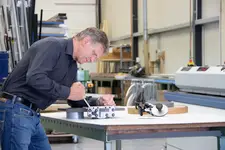Mobile edgebanding machines, as e.g. the Wegoma set, allow you to apply edgings safely and easily to boards on the construction site. If you don't have a machine, you can alternatively use one of our T-bar edgings. We can also retrofit all ABS edgings from a thickness of 2 mm with a T-bar. This is how: mill 3.5 mm wide grooves into the boards, tap in the T-bar edging after applying REDOCOL Kantol greenline edging glue, mill flush after one hour, done. For the processing of mitred boards or protrusions, the T-bar can be fitted more on the right or the left side of the edging upon customer request.
Special tip: If you work with special requirements, e.g. in the kitchen, laboratory or bathroom, you can also use mobile edgebanding machines to process PUR adhesive. When the work is done, stir half a handful to a handful of blue PUR cleaner granulate into the gluepot and allow a residual edging to run through until the PUR/cleaner mixture is on the roller. The hardened mixture can then be reheated and removed the next day.
